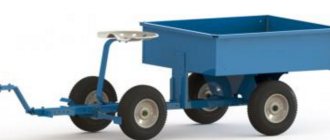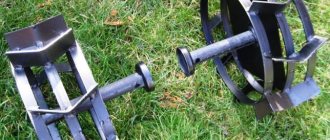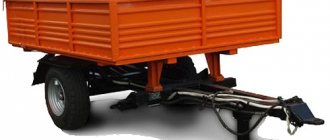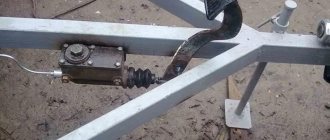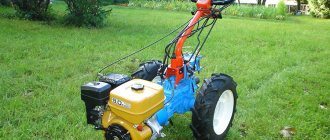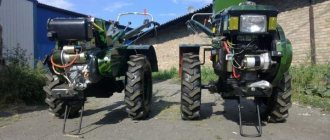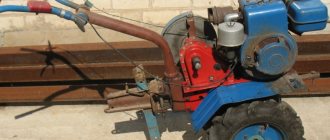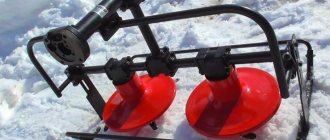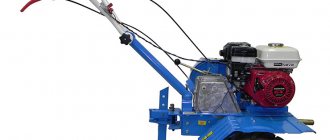A trailer for a walk-behind tractor is a valuable device in a modern economy. The walk-behind tractor itself greatly facilitates and speeds up the farmer’s work; its indispensable part is the trailer and other attachments. The trailer is used for transporting various cargoes; it is indispensable when removing waste from the site. The scope of use of this design is very wide.
A trailer for a mini tractor is in demand in dairies, farms, greenhouses and public utilities. It is necessary to use a tow hitch taking into account the fact that its appearance on public roads is unacceptable.
A car trailer attached to a walk-behind tractor does not require periodic maintenance. If the attachment is used for its intended purpose with proper care, the trailer will not lose its performance for a long time.
What to look for when choosing a trailer/adapter for a walk-behind tractor
When planning to purchase a trolley for a walk-behind tractor, consider:
- trailer category. Only a walk-behind trailer is suitable for a walk-behind tractor. A car is absolutely not suitable because it is not equipped with a brake system and an operator’s chair. Even if such a design can drive on a flat surface, and even then not without errors, it simply will not hold up on a slope. This is especially true for low-power walk-behind tractors;
- material. Galvanized and steel models are the most practical and durable, but they are also more expensive. Plastic ones are cheaper, but they will not last long and are only suitable for light loads;
- load capacity - this is indicated by the number in the model name.
Wheels are also of great importance - especially if the garden is located in a lowland, where the soil is viscous and has a high level of humidity. Most often, models with 4x10-inch wheels are purchased.
Important trailer elements
- Body . Don't skimp on materials; choose trailers made of painted metal. Capacious models will require a more powerful walk-behind tractor.
- Wheels . The ability of a cart to drive through sticky, loose soil depends on the width of the wheels. The wider the chamber, the better the maneuverability.
- Drawbar . The elements differ in the method of fastening. When choosing, you need to clarify whether a particular cart will fit your walk-behind tractor. There are also drawbars with universal fastening.
- Wings . A necessary element that prevents stones and dirt from flying away from under the wheels.
Do you need a license for a walk-behind tractor - answers and advice
In rural areas, you can often see moving transport equipment called a walk-behind tractor. This device is very popular, since without it the landowner would have to manually cultivate quite large areas of land.
But thanks to this unit, its owners can easily carry out all agricultural work.
Owners of this unit are constantly faced with a dilemma: do they need a license to a walk-behind tractor in order to legally operate it? Why do you need a license to move around the city? What if, in order to get to the site, you need to cover some distance along the highway? We will try to answer all these questions.
Can a walk-behind tractor be called a vehicle?
In order to finally decide whether it is necessary to have a license that allows you to drive a walk-behind tractor, you will first need to decide whether the walk-behind tractor is a vehicle at all.
The presented equipment itself does not fall under the definition of a vehicle.
Firstly, this is due to the fact that this is indicated in the instructions for using walk-behind tractors, which states that the device in question is not intended to be used for driving on highways.
Secondly, even in legislation of this kind, agricultural machinery does not belong to the category of vehicles. In this regard, there is no need to register the walk-behind tractor with state registration. Moreover, he does not need to undergo a technical inspection or have cargo issued for him. The movement area of the device is limited to movement around the homestead, farm or garden.
The issue of traveling on a public road
We have already found out that this device does not fall under the category of a vehicle, but the question of whether the walk-behind tractor can be driven on public roads remains open.
What to do if the only way to the site is through the highway? It is in this situation that many owners of this equipment receive a fine from the traffic police inspector.
Let's figure out how you can avoid this and get out of this situation safely.
Any representative of the road inspection has the right to demand that a person provide him with a document that indicates that he has knowledge of the rules of the road. When driving such a vehicle with a passenger, the inspector has the right to issue a fine, since only a vehicle can transport people.
To ensure your safety from a fine, it is recommended to follow the following instructions:
- In the absence of any category of rights, you must first open category A, which gives the right to drive a motorcycle. This will serve as proof that you are familiar with the rules of the road and have an idea of what standards must be followed on the roads;
- You must have your driver's license with you while driving;
- The walk-behind tractor must be equipped with low beam headlights or daytime running lights must be available;
- The trailer must be equipped with installed red light reflectors.
If you follow the above tips, you can become a full-fledged participant in the road traffic, who will be subject to the relevant rules.
Age after which you are allowed to drive a walk-behind tractor
The operating information does not provide any data on how old you are allowed to drive this agricultural equipment.
When work is expected only in the territory of a vegetable garden or orchard, then it is enough for the driver to be able to correctly control this device.
Naturally, a child at the age of 12 is not physically able to operate a walk-behind tractor, since it will require the use of force for proper ownership and control, as well as understanding the safety rules.
If you have to move along the roadway on a walk-behind tractor, then, as mentioned above, of course, the driver must have the appropriate license. Such rights can only be obtained by a person who has reached the age of majority.
We can summarize that in order to operate a walk-behind tractor on your plot, vegetable garden or garden, you do not need to have a license.
However, provided that you are often a participant in traffic and constantly travel onto the roadway, you must have the appropriate document with you.
How much does a reliable walk-behind tractor cost: we understand the issue of pricing
Buying a walk-behind tractor is a joyful event for everyone involved in agricultural work. How much it will cost financially and how to choose the right walk-behind tractor in terms of price/quality ratio are far from idle questions.
To make work in the fresh air beneficial and enjoyable, without reminiscent of the labor feat of the heroes of “Virgin Soil Upturned,” let’s together see which walk-behind tractor is best for you.
Let's sum it up
- The cheapest walk-behind tractor . This category includes light gasoline walk-behind tractors with a limited number of functions, suitable for infrequent seasonal use and amateur agricultural work. The engine is Chinese or assembled in China.
- Dearest. Heavy diesel walk-behind tractor for professional agricultural work. The engine is Chinese or assembled in China.
- Balance of price and quality. Gasoline tractor , providing great opportunities for use in any conditions. Engine - Japanese or American (Subaru, Briggsstratton).
To make the right choice, simply simulate the situation: won’t you overload a cheap gasoline walk-behind tractor , or won’t an expensive diesel one stand idle in vain? What fuel is most available in your area? Wouldn't it be cheaper to refuel with gasoline? What additional accessories are required? By answering a number of simple questions for yourself, you will save time, effort and money.
Homemade attachments for walk-behind tractors
The list of attachments for walk-behind tractors is very diverse. It includes:
- plows;
- harrows;
- rake;
- potato diggers, hillers and potato planters;
- mowers;
- flat cutters-weeders;
- rotary cutters;
- seeders; sweepers and snow blowers;
- wood splitters;
- dumps;
- water pumps;
- spray pumps, etc..
Obviously, such a rich arsenal of attachments is not included in any configuration. One can only imagine how much, in addition to the walk-behind tractor itself, it will cost to purchase all the units necessary for farming. Don’t forget that there are only a few truly universal walk-behind tractors on the market. That is, equipment that fits a particular model can rarely be connected to another. Fortunately, manufacturers still provide for the possibility of modifying their walk-behind tractors, mainly through additional attachments. These include:
- additional axle shafts (hubs);
- creepers;
- weights (weights);
- lugs;
- seat adapters;
- transport carts and trailers;
- openers (thrust arms);
- couplings, etc.
Any of these units can be made independently or taken from other models and adapted to yours. But first of all, you should make sure that they are compatible. Engine power, dimensions and weight, connection method, workloads, etc. – all this should be taken into account at the development stage, otherwise you risk wasting effort and money.
Assembling a homemade trailer for a walk-behind tractor
When starting to implement a project, a DIYer needs:
- create a working draft or drawing (drawing);
- prepare material for the frame and other main components;
- prepare the workplace;
- mark the main structural elements of the trailer;
- lay out and adjust alignment angles;
- collect part templates;
- carry out the adjustment of the purchased entire units to the structural elements.
Required tools and materials
To carry out the work, you need to prepare all the necessary tools:
- welding machine;
- grinder with a set of cutting and abrasive discs;
- measuring instrument - tape measure, metal ruler, protractor, square, marker and chalk, metal scriber;
- hammer, chisel, pliers;
- bench vice, set of clamps, welding clamps;
- drill, set of metal drills;
- riveter
The required materials will be:
- steel square or rectangular pipe 60×60 or 60×30 mm;
- steel square pipe 30×30 or 25×25 mm;
- corner 25×25 mm;
- channel;
- springs of the Moskvich passenger car;
- steel sheet 2 mm thick;
- galvanized sheet 1 or 0.8 mm thick;
- fasteners, bolts, nuts, rivets.
For a rigid body model, instead of a spring-loaded wheel set on springs, you will need a regular beam.
For trailer wheels, ready-made car wheels from a Tavria, Moskvich or Zhiguli passenger car are suitable.
The wheels need to be selected immediately with the hubs, this will facilitate further assembly of the homemade product.
The trailer frame is an all-welded structure in the form of a frame lattice made of a square pipe. Traverses made from a 25×25 mm square form the cross members of the frame, and the spars are made from a 60×60 or 60×30 mm pipe. After marking, all structural elements are cut and laid out on a flat surface, the joints are welded with small seams, and each joint of the elements is checked with a square. After assembling the structure, final welding of all parts is carried out along the perimeter of all planes. The frame is painted after treating the surface with a metal primer.
Chassis
In making a homemade trailer for a walk-behind tractor, the chassis is the most difficult element.
The basis of the chassis is a beam with hubs at the ends. The channels are joined to each other in such a way that they form a square. The joints are welded with a continuous seam. Wheel hubs are installed at the ends of the axle and welded.
The accuracy of the axle assembly is checked by checking the parallelism of the planes of the wheel rims. The connection between the frame and the beam is carried out using springs, while the ends of the springs are installed in welded brackets on the frame, and the beam is pressed against the central part of the springs using an earring.
The chassis installed on the frame is additionally checked for resistance to overturning. As in a car, the axle spring group must have rubber bushings in the frame mounting bracket.
Body, frame trim
The platform is marked relative to the grid in such a way that allowances are left for attaching the side posts. The front and side boards are firmly installed, and the rear board is made removable on door hinges.
The sides of the trailer have a frame structure made of 25x25 mm corners. The corners are butt welded, the seams on the inside are cleaned to the level of the metal plane.
Removable sides are assembled in the following sequence:
- side frame;
- The galvanized iron sheet is adjusted to the size of the frame;
- The side panels are cut out and secured with rivets through the corner.
The bottom of the body, made of a 2-mm iron sheet, is installed on the frame and welded with a small seam around the perimeter every 3-5 cm.
The installation of the boards begins with the installation of the front board, then the side boards are installed and connected with a welding joint.
The tailgate is secured last - first the hinges are marked and welded, and then the latches.
Other design details
After assembling the frame and body, a folding seat is installed - a wooden bench placed on top of the front side with support on the sides.
As a trailer brake system, it is recommended to use elements of the brake system of a car whose hub and wheels are used in the design. To ensure reliable operation of the brake system, it is recommended to provide an additional lever lock.
Read about attachments for the Neva unit in this article.
How to assemble a trailer for a walk-behind tractor with your own hands
The trailer (adapter) is simple in design, but the assembly procedure will require attention and certain skills. Moreover, you will definitely need drawings and video instructions - inaccuracy or carelessness can lead to the fact that the adapter will quickly fail or not work at all.
Required tools and materials
To work you will need a set of:
- welding;
- electric drills;
- file;
- square;
- steel sheet 5 mm;
- several square pipes (1 inch);
- fastenings.
It is based on two key elements: a hitch and a wheel locking unit. The hitch is a structure made from two welded parts of square pipes and one part from a water pipe - it is inserted into a rod with a tee.
For the assembly, two ten-centimeter sections of pipe are welded at an angle of 90 degrees. The horizontal part is inserted into the mounting pipe and secured with a bolt; the axle, wheels and bearings are mounted on the vertical.
Assembly, step by step instructions
The procedure consists of a serial connection:
- frames;
- steering wheel and control pedals;
- trunk;
- swivel bracket;
- braking system.
At the last stage, the axle with wheels is installed. Spare parts from an old moped or motorcycle may be suitable for this. Elements that are too long are shortened with an electric hacksaw.
Main characteristics of walk-behind tractors
The main characteristics of walk-behind tractors include:
- transport speed (for most models does not exceed 10 km/h);
- overall dimensions, including width, length, height, weight, ground clearance, track;
- types of tires and air pressure in them (if the tires are pneumatic);
- number of gears (usually one reverse and two forward);
- type of internal combustion engine and transmission;
- quantity and type of oil poured into the gearbox of the engine and walk-behind tractor;
- power and performance;
- type of steering device (rotary steering column or rods);
- presence/absence of headlights.
How to choose a trailer?
When purchasing a trailer for a mini tractor, you need to look at its tonnage, the number of available functions, and the serviceability of the brake mechanism. The main criterion for selection is the power of the mini tractor with which the tow hitch will be used.
Trailers differ in the material from which they are made:
- There are galvanized models and products made of plastic or steel. The most expensive and high-quality are galvanized carts. When choosing, you need to take into account the material of manufacture, as well as the thickness of the walls. A model with thin sides is not as high quality and cannot withstand mechanical stress.
- If during operation mainly bulk cargo will be transported, it is worth purchasing a tipper model, but when using it, it is worth remembering that before tipping over you will have to disconnect the trailer from the mini tractor. In other cases, the on-board model is the most convenient.
- A car trailer for a walk-behind tractor is presented on the market in 2 variations: with or without wheels. If you plan to purchase a trailer with wheels, you need to pay attention to the hubs in them. Steel hubs are the preferred option as they are more durable. There are also cast iron hubs, but they break easily when the wheels are used on poor quality roads. In this case, it is better to overpay, but choose reliable ones so that the device for the walk-behind tractor does not go out of use in a year.
A cart mounted on a walk-behind tractor with a tonnage exceeding 350 kg must be equipped with a mechanical brake. Before purchasing a product, it is recommended that you test its operation if possible. Trailers with a tipper design must be equipped with a hydraulic drive. As for single-axis products, a manual device is sufficient.
A device trailed on a walk-behind tractor has the following advantages:
- Ability to move loads uphill in any road conditions.
- Transportation speed can reach 10 km/h.
- Improves the stability of the mini tractor.
- The use of a tow hitch is acceptable at any time of the year.
The choice may also be influenced by the cost of the trailer for the walk-behind tractor. The price of attachments for walk-behind tractors is determined by the following components: the number of axles, material of manufacture, tonnage, internal dimensions, the presence of extension walls, the presence of pneumatic brakes, ground clearance, etc.
Another interesting article: Rakes for tractors and walk-behind tractors
We determine the main characteristics of the trailer - we focus on factory models
The design of the cart for the walk-behind tractor is not super complex. If you have an angle grinder, electric welding and a drill, almost any owner of a manual mini tractor can make a trailer on their own. The main thing is that before assembling the trolley, correctly draw up its drawing or sketch, and then, strictly according to it, carry out all the work. To do this, you first need to decide on the main characteristics of the trailer: load capacity, dimensions and some others. To simplify this procedure, it is recommended to focus on factory-made, industrial models of walk-behind carts.
Factory trailers are produced with a carrying capacity ranging from 300 kg to 1000 kg with bodies of different sizes. These parameters depend on which walk-behind tractor the trolley is intended for use with, or, more precisely, on its technical characteristics. In accordance with this, there are 3 main types of trailers: heavy, medium and light manual mini tractors.
With heavy ones, power over 10 hp. Walk-behind tractors, as a rule, use single- or two-axle carts with a body 2–3 m long and 1.2 m wide. Such trailers are designed to transport cargo weighing 500–1000 kg.
Trailer for walk-behind tractor for transporting heavy loads
For medium hand mini tractors - with power from 4.8 to 10 hp. – single-axle bogies with body sizes of 1.0×1.5 m, 1.1×1.4 and similar are oriented. Their carrying capacity is 300–500 kg.
With light walk-behind tractors with a power of up to 4.8 hp, single-axle trailers with a body 0.85–1.15 m long and 1 m wide are usually used. The load capacity of these carts is no more than 300 kg.
The height of the sides of factory standard trolleys for walk-behind tractors is 30–35 cm. On heavy-duty trailers, side railings of a frame structure are installed, the height of which is 50–60 cm.
To make loading and unloading easier, the rear side of the trolleys is foldable and removable. On some models, in addition to the rear one, both side ones can be opened and removed, which increases the convenience of filling the body with cargo and emptying it.
Hinged tailgate of the trolley
All standard trailers are manufactured as tippers. On models for medium and light walk-behind tractors there is no hydraulic lifting cylinder and this function is implemented through the design of the trolley. The body on the trailer is installed so that its center of gravity and the load located in it is located on the rotary axis aligned with the wheel pair of the trolley. This balancing greatly facilitates manual tipping.
This is due to the fact that when descending a steep slope, it is impossible to extinguish the inertia of movement of a loaded trailer with only the 1st brake of a hand-held mini tractor. Therefore, trolleys for heavy walk-behind tractors must be equipped with their own braking system.
the best walk-behind tractors
a walk -behind tractor is called a mini tractor, because it is just such a traction device that can be used to separately drag attachments from behind, attach a trailer, push a shovel from the front, or transmit torque to the power take-off shaft (mowing grass, clearing snow). In addition, the units can connect cutters for active grinding of soil. From the rating you can find out the best walk-behind tractors of various classes for small gardens, medium-sized plots and large fields, which will help you choose equipment with optimal parameters and not overpay.
This model is equipped with a gear-type gearbox with a housing made of aluminum. Gear shifting occurs due to V-belts, which ensures safety and ease of control for the user. The engine also has a two-stage cleaning filter.
This unit is designed for ground work only and can be modified with additional equipment. There is no power take-off shaft installed here, so all attachments are attached using a bracket. It is possible to adjust the steering bar in height.
FM-653 M is used during planting and harvesting, and tillage.
FM-1511 MX
This is a powerful motor cultivator that can handle any type of soil, as well as virgin soil. Thanks to its heavy weight, high power and enlarged wheels, the unit is comfortable to operate and stable during operation. Due to the rotary axles, the equipment can be rotated 180° in place. The handle is adjusted to the user's height.
The size of the area that the FM-1511 MX is capable of processing is up to 5 hectares.
| Motor power | 15 l. With. |
| Forward gears | 2 |
| Reverse gear | 1 |
| Hitch | Universal type |
| Tank volume, l | 6 |
| Tillage width, m | 1,35 |
| Plowing depth, m | 0,3 |
| Weight, kg | 145 |
- increased power reserve due to the cylinder (volume 0.5 l);
- the compression level is reduced, which allows you to start the equipment under any temperature conditions;
- gear type drive;
- easy turn back;
- handles with anti-slip coating;
- Thanks to the wheelbase, slipping and additional load on the cultivator engine are eliminated.
Manufacturing a multifunctional trailer
Stage #1 – preparation of materials for construction
When planning to make a trailer yourself, you must first develop a drawing in which to calculate the dimensions of the structure and imagine its future appearance.
When thinking about the dimensions and load-carrying capacity of the structure, you should expect that with the help of a trailer in one trip you can transport an average of 6-7 bags of vegetables, the total weight of which is about 400-450 kg
Having decided on the size of the trailer, you need to calculate the required number of meters of rolled metal. You also need to calculate the number of channels that will act as a frame for the hitch. By paying enough attention to this stage, you can not only save costs by protecting yourself from the possible costs of purchasing extra screws and corners, but also be confident in the correctness of your actions.
When making a homemade trailer, there is no way to do without a welding machine, since the functional design will not last long with self-tapping screws.
To build a strong trailer frame, steel angles with sections of 50x25 mm and 40x40 mm, as well as cuttings of rectangular and round pipes, are suitable. To make a trailer body, you will need 20 mm thick boards and 50x50 mm timber for the support beams.
Stage #2 – production of basic elements
As a basis for manufacturing, you can take a ready-made design of the structural part.
The trailer has an increased safety margin, which allows it to be used on difficult terrain surfaces
The design has four main components: body, carrier, frame and wheels. All of them are connected by welding.
To increase the strength of the structure, four stiffening ribs are provided in the area where the drawbar meets the body of the rotary unit
The body is a wooden structure assembled from 20 mm boards, the corners of which are equipped with steel corners. The body is attached to the trailer frame using three wooden beams - support beams.
The trailer frame is made from a set of steel elements: pipes, angles and rods
Since such a trailer is a single-axle structure, the load distribution must be such that the center of gravity is shifted to the front, without going beyond the axle of the wheels. The only drawback of this body is that there are no folding sides. If desired, the design can be slightly improved by installing folding walls. It is also advisable to make side loops with straps on the body, which will be necessary to secure the cargo during transportation.
Stage #3 – arrangement of the chassis
The chassis of the structure is one of the key ones in the manufacture of a homemade trailer for a walk-behind tractor.
You can purchase new wheels and springs, but it is much easier to use used parts of a domestic car, for example, from a Moskvich or Zhiguli.
In our case, the trailer is equipped with wheels that were removed from the SZD motorized stroller and used as an assembly with the hub. To match the axial rod with the diameter of the hub bearings, it is necessary to sharpen its ends.
When arranging the wheel axle, it is enough to use a steel rod with a diameter of 30 mm. The length of the rod should be such that when the structure is assembled, the wheels do not protrude beyond the rims of the body. The rod is attached by welding through gussets and corner supports to the side members and the body of the longitudinal hinge.
To connect the trailer to the walk-behind tractor, you need to make a console. It will be attached to the attachment bracket, so its upper part should follow the contours of the hiller holder. The lower part of the console is an axis around which, with the help of angular contact bearings in a fixed position, the rotating assembly of the carrier rotates freely.
The original version proposed by the author provides for an articulated connection between the carrier and the trailer
The drawbar is inserted into the tubular body of the longitudinal hinge and secured with a thrust ring. This design solution makes it easier to control the unit on uneven surfaces, since the wheels of the trailer will work independently of the wheels of the walk-behind tractor itself.
The trailer is almost ready for use. All that remains is to place a seat for the driver in front of the body and attach a footrest in a special frame to the drawbar of the driver, which you can lean on while driving.
Trailer device
A standard trailer for a walk-behind tractor consists of the following elements:
- the frame to which the remaining elements are attached;
- wheelset;
- driver's seats;
- body necessary for transporting goods;
- a hitch with which the walk-behind tractor itself is connected to the trailer.
Additional elements are also possible. For example, the mechanism by which the body is tilted.
Popular models of trolleys for walk-behind tractors include:
- TPM-350-1 galvanized trolley with Mobile K folding side;
- TMP-350 dump truck with Mobile K folding side.
How to make a homemade trailer hitch for a walk-behind tractor
If you decide to make a homemade trailer hitch for a walk-behind tractor, then let's get down to implementation. To make this trailer, you will have to spend several days of work. The trailer's carrying capacity was calculated based on the weight of the transported cargo of 400-450 kg. When tested, the trailer could easily hold 6-7 bags of potatoes.
There were no problems with overload. The trailer was designed for transporting goods in bags, so there are no folding sides.
We think through the constructive part of the project in advance. The trailer will consist of a fairly durable carrier, a body, a frame made of steel corners and reliable wheels.
- Bracket for walk-behind tractor attachments;
- Console;
- Tow hitch;
- Step, use board s20;
- Driver's seat, use s20 board;
- Frame;
- Body, use s20 board;
- Support beam, we use three 50x50 beams;
- Bolt M8;
- A persistent ring, we use a 58x4 pipe;
- Two wheels removed from an SZD motorized stroller.
The trailer hitch for a walk-behind tractor consists of several parts. We connect the different parts together by welding. The junction of the drawbar and the turning part is the most loaded, so we reinforce this place with additional stiffening ribs.
To make the frame we use scraps of round and rectangular pipes and steel angles. The design will be slightly intricate, but with an additional margin of safety. The reason was the difficult terrain and difficult operating conditions of the trailer.
1. For bracing we use a corner 21x21x3; 2. We also make the frame for the seat from a 21x21x3 corner; 3. We make the riser from a pipe 50x25x4; 4. We make the seat posts from a 40x40x4 corner; 5 and 14. For the front struts we use a 50x25 pipe; 6 and 15. For longitudinal spars we use a corner 40x40x4; 7 and 8. We make the right wheel axle supports from a 32x32x4 corner; 9 and 16. We make the rear struts from a 50x25 pipe; 10. To make a reinforcing cross member, we use a 40x40x4 corner; 11. We make the body of the longitudinal hinge from a 58x4 pipe; 12. To make the wheel axle we use a rod with a diameter of 30 mm; 13 and 17. For transverse spars we use a corner 40x40x4; 18. To make a scarf, we use metal s4.
If large loads on the trailer are not planned, you can make a simpler option.
- Rotary housing;
- For the drawbar we use a pipe 49x3, L1820;
- For the frame of the footrest we use a corner 25x25x4;
- For support we use a 58x4 pipe;
- For the stiffener we use s4 steel;
- For the lining we use a 25X4 strip.
Wheel axle for trailer to walk-behind tractor
To make the wheel axle we use a steel rod with a diameter of 30 mm. We connect it by welding to the side members and the body of the longitudinal hinge, using corner gussets and supports. The wheels should not protrude beyond the dimensions of the body, so we choose the correct axle size. The body is knocked together with 20 mm boards and reinforced with a steel angle. Next, it is attached to the frame with three strong, supporting beams of 50x50 timber.
https://youtube.com/watch?v=tD8pjrbcRtQ
The center of gravity of the transported cargo must be closer to the front, as is customary for single-axle trailers. The wheels are taken from an SZD motorized stroller. They are used assembled with the hub, and the ends of the axial rod are machined in accordance with the diameter of the hub bearings.
Trailer hitch
To connect the trailer to the walk-behind tractor, a tow hitch is made. The shape of the upper part of the console is taken from the hiller holder, since the standard attachment bracket will be used for fastening. The swivel assembly of the tow hitch is fixed around the axis in the lower part. Between the angular contact bearings, the remaining space must be filled with grease and covered with anthers.
We make the connection between the towbar and the trailer articulated, depending on the complexity of the trailer’s operation. The drawbar must be inserted into the tubular body of the longitudinal joint and secured. This solution will allow the trailer to be independent of the wheels of the walk-behind tractor, which makes it very easy to control the trailer on strong uneven surfaces.
The components of the carrier rotating assembly are:
- tow hitch (1),
- anthers (2),
- bearings 36206 (3.6),
- body (4),
- spacer sleeve (5)
- remote (7),
- washer (8),
- nut m20x2.5 (9),
- oiler (10)
- drawbar (11).
There is a seat for the driver in the front part of the body. It is made with a very soft base. So that the driver can rest, a step is made on the drawbar. In other words, the driver uses the control levers with his hands, and rests his feet on a special footrest.
How to make a cart for a walk-behind tractor with your own efforts
For most people, a walk-behind tractor is one of the most important and useful tools for household purposes. Thanks to it, you can not only cultivate the soil, but also transport various things: all kinds of fertilizers, or hay, fuel or harvested crops. But how can this be done if this tool does not have any special devices? The way out of this situation is quite simple and it can be a cart for a walk-behind tractor.
It is quite possible to make it yourself, and, by the way, you can save your money. And all because to make such a cart you will need quite ordinary materials that are of low cost. And so that the trolley for the walk-behind tractor turns out to be durable. It is worth making it yourself, using modern drawings and dimensions of other similar products.
Main structural elements of the trolley
Now we will try to consider the simplest design of a trolley, which will easily transport up to 450 kg, and such a trolley will also be equipped with a comfortable driver’s seat.
Any trailer can be divided into the following structural elements:
- trolley with body,
- wheels,
- central frame,
- driver's seat.
Since large loads will fall mainly on a certain area, the entire cart should be reinforced with special stiffeners.
What materials is the trolley frame made of?
It is necessary to weld the frame very carefully, since it will withstand bad rural roads.
What can wheel axles be made from?
In order to make an axle for the wheels of a future cart, you need to take a metal rod having a diameter of 30 mm and connected by a weld to a longitudinal hinge and to corner supports. The length of this rod should be approximately 1050 mm (not less). It is necessary to select it in such a way that the wheels of the cart cannot go beyond its limits.
We make a body for a cart.
If you want to know what materials the cart for the walk-behind tractor is made from, then you should know that inexpensive but very durable materials can be used for this case. As for the installation of this product, remember that you can quite easily mount the body yourself from wooden boards with a thickness of 20-25mm. By the way, they will be fixed to the corners with special steel corners. These boards are mounted to the frame using bolted connections.
Since you will have to transport large loads, it is best to make the sides folding: due to this, it will be easier for you to unload large-volume things. You can use old wheels from some old agricultural machinery as wheels. But if you don’t have time to look for them, then wheels from a regular motorcycle stroller may also be suitable.
The axle must be sharpened to the required diameter. This trolley for a walk-behind tractor will have excellent maneuverability. It will be possible to transport any cargo on the most impassable roads.
We manufacture a trailer hitch from any piece of metal. To do this, you will need to make a hole in it that our hitch can easily fit into.
It is best to make a rotating unit from a bearing that has the diameter you need. It must be well secured by welding. These bearings should be covered with special boots, filling their entire space with lubricant. If you do not properly protect the bearings from external influences, the cart will not serve you for long.
Now it's time to make the bottom of the cart for the walk-behind tractor
. And the bottom can be made from edged boards. But a more reliable option is sheet metal. It is best to choose a sheet with a thickness of 2-3 mm.
Now you know how to make a trolley for a walk-behind tractor
with your own hands. In addition to our recommendations, you should watch a video on this topic. And if you do everything correctly, then this walk-behind tractor trolley will serve you faithfully for a long time. Overall, we wish you good luck in constructing this item.
Features and recommendations when assembling a trailer
When preparing and during the process of assembling the trolley, the following features require attention:
- Before starting to assemble the walk-behind tractor, it is necessary to take into account the weight used; it is especially important to determine the center of gravity; it may be closer to the carrier and in no case protrude beyond the rear wheel axle. The main purpose of the trailer will be to transport cargo, therefore, when creating a cart, the main thing is to ensure low weight and acceptable load capacity;
- A do-it-yourself cart for a walk-behind tractor is cheaper than a purchased one. Making a trailer for a walk-behind tractor with your own hands is more profitable than buying a ready-made one. This is especially important if existing materials are used during assembly;
- Factory-made trolleys sometimes have low quality elements, this is expressed in the form of poor quality materials for the body, weak axle, small wheels, etc., which affects the service life of such a part. It is especially important that with the small diameter of the wheels of the walk-behind tractor trolley and the poor quality of the tires, their use is significantly difficult;
- Factory carts for a walk-behind tractor are not much different from trailers for mini-tractors or cars, but the walk-behind tractor is less powerful and has different tasks. The strong difference in the power of the transport unit with the cart affects the efficient performance. Each craftsman will make a trailer for a walk-behind tractor with his own hands using available resources; installation of the seat, fastening mechanism and other inconsistencies may appear during installation.
Here are some recommendations on how to make a cart for a walk-behind tractor with your own hands:
- Body installation. When installing from metal, it is better to use a galvanized sheet with a thickness of at least 3.5 mm. It is necessary to attach stiffening ribs to the sheet (usually the rigidity around the perimeter of the body is sufficient). Also use stiffening ribs on the sides;
- About the use of wheels. It is proposed to take wheels from garden wheelbarrows with a large diameter, bicycle wheels from “mountain” bikes or motorcycle wheels. It should be taken into account that the diameter of the wheel affects the cross-country ability; the larger it is, the higher the cross-country ability. The width of the wheel also affects the cross-country ability of the trolley; the wider the track, the better. The design of the chassis cannot be heavy, since this reduces the payload on the trolley;
- Creation of a self-dumping system, provided that such a function is used. The attachment point for the trailer to the walk-behind tractor must be purchased from a factory, since it is quite difficult to make them yourself, and ready-made units are inexpensive and quite widely available on sale;
- Frame. To mount the frame, you can use a profile, small diameter pipes or a corner. The frame must be reliable and resistant to loads. To install the seat, you can use parts from old chairs, chairs, both household and car.
Basic rules for choosing a trolley for the Neva walk-behind tractor
Trailers for walk-behind tractors, be it Centaur, AGRO, Neva MB2 or Motor Sich, are not designed for movement on busy roads, not to mention highways. Their main purpose is to transport goods from vegetable gardens and summer cottages, while it is better to move them outside the road network so as not to create an emergency situation on the roads.
When choosing a trailer for a Neva walk-behind tractor, as for any other brand, you need to correctly correlate the trailer’s carrying capacity and the power of your mechanical worker. If we talk about choosing a trolley for the Neva walk-behind tractor, then, with the exception of the model range of heavy MB-23 models, the entire remaining line of models is equipped with engines from 5.5 to 7.5 hp. Therefore, the optimal solution for them would be to choose a tow hitch with a carrying capacity of 250 to 500 kg. The towbar for the Neva MB 23 walk-behind tractor can be taken with a lifting capacity of up to 1 ton. These powerful mechanisms are strong enough to pull such a load.
The remaining rules when choosing a trailed cart for any walk-behind tractor, incl. and for Neva they are dictated not so much by concern for the walk-behind tractor, but by common sense and ease of use
When choosing, you need to pay attention to:
- Body material. It is better to choose a cart whose body is made of galvanized steel - it is not afraid of frost, heat, rain or dirt.
- The presence of folding sides and tipper body tipping to make loading and unloading the cart easier and more convenient.
- Availability and quality of brakes. Since you often have to transport loads with a walk-behind tractor on uneven terrain, having reliable brakes on a steep descent will save you from major troubles.
By following these simple rules, you can choose a trailer for the Neva walk-behind tractor that will serve you for many years. But if for some reason you don’t want to buy a factory trailer, then it’s easy to make it yourself. The main thing is to find good drawings of a homemade trailer hitch and acquire the necessary tools and materials for this. But this is another topic for discussion.
Preparation of a drawing of a trailer for a walk-behind tractor
What size should a homemade trailer for a walk-behind tractor be:
- If you have a light type of walk-behind tractor, then the width of the trailer should be 1 m, and the length should be 0.85 - 1.15 m. The load capacity of such a trailer is about 300 kg.
- If you have a walk-behind tractor with a power higher than 5 hp. s., then the following dimensions will be: width - 1 m, length - 1.4 - 1.5 m.
- For heavy units, a trailer with a width of 1.2 m and a length of 2 - 3 m is suitable. They are often biaxial.
Next, you need to create your own drawings and select the dimensions of the trailer you need. Only its precise design will allow you to successfully create a structure that will serve for many years. Here is an example of a drawing of such a body.
Body frame drawing
How to make a trailer for a walk-behind tractor with your own hands - assembly steps
For a regular frame we only need 2 tubes and wheels on bearings. We can directly attach the body itself to the finished frame. In order to soften the shaking on potholes, you just need to install a spring. We assemble a homemade walk-behind trailer. To begin with, an additional one is attached to the main pipe, which will act as an axis. Then, on the other side, a hitch for the walk-behind tractor trailer is mounted. We weld hubs to the ends of the axial tube. Next, we secure the wheels and attach the parking stop
We attach the body, fenders and seat. The body is best made of wood or metal. Particular attention should be paid to the trailer hub; it must be strong and reliable.
How to make trailer brakes on a walk-behind tractor?
In order to install homemade brakes on the body and ensure a safe ride on a walk-behind tractor, you should acquire several parts for its design:
- Brake pads from a motorcycle.
- Motorcycle brake drum.
- Spokes from a motorcycle wheel.
- It is better to install the brake on both wheels. This will allow the equipment to effectively brake.
Stages of work:
- We remove the rods and cables from the disk and clean it.
- We put machined drums on the hubs and secure them at the back.
- The free space that has formed between the ribs of the drums must be wrapped with metal wire.
- We place the collapsible disk on the axle and secure it with bushings.
- We weld a piece of metal onto the axle to prevent the disc from moving.
- We mount the cables on the drums and pull them to the control.
- The control system may be a lever with a gear.
In principle, having a good diagram with accurate calculations, you can easily design both a single-axle and a two-axle dump body yourself. The main thing is to know how to do it and follow all instructions. By making this equipment yourself, you will find an incredible assistant for working on sites.
Which trailer is better: TOP 5 best brands and their price
SCOUT-700
If you are looking for a reliable model of a walk-behind trailer and don’t want to spend a lot of money, then the Scout will clearly suit you. The unit is quite easy to use. Moreover, the presence of reliable disc brakes on it is a guarantee of trouble-free operation.
The price of the Scout-700 trailer is approximately 48 thousand rubles.
Characteristics:
- load capacity – 1 t;
- purpose – transportation of goods.
Advantages:
- the presence of a folding side facilitates the loading and unloading process;
- Ease of Management;
- presence of an additional protective block for the driver.
Flaws:
- none.
